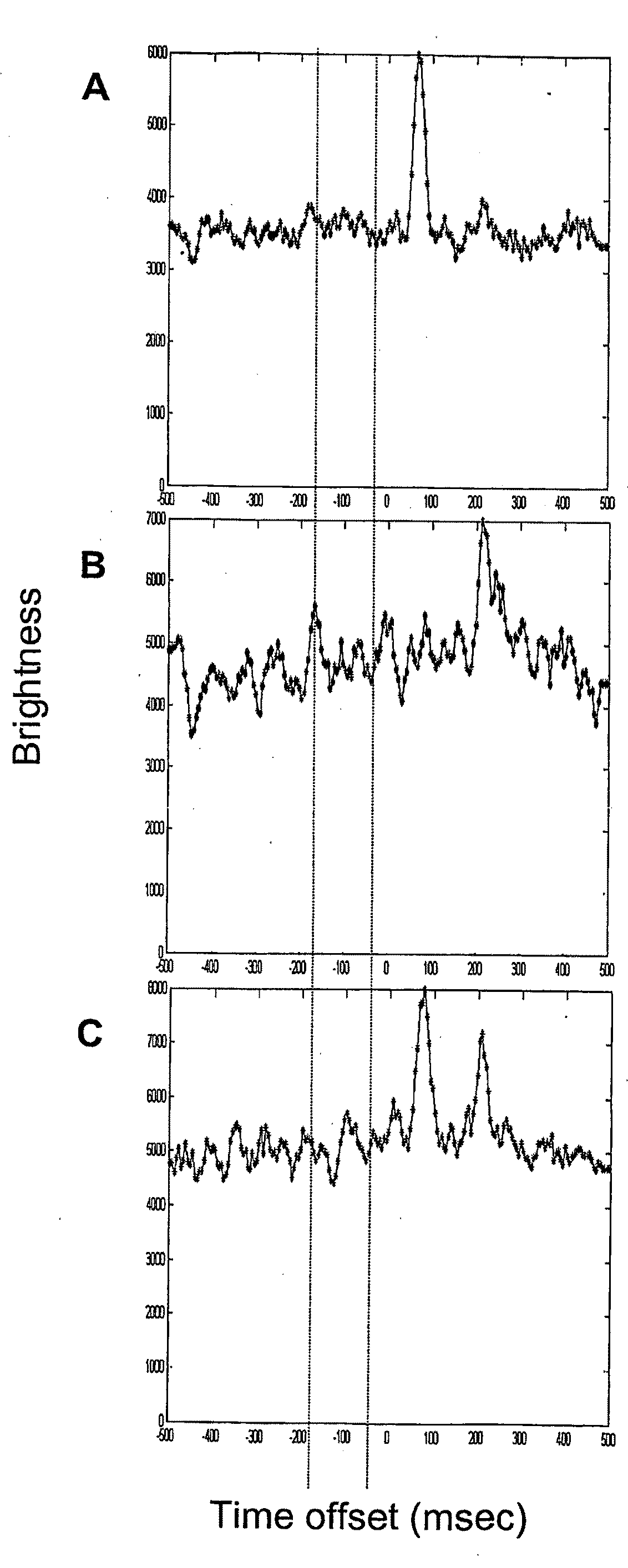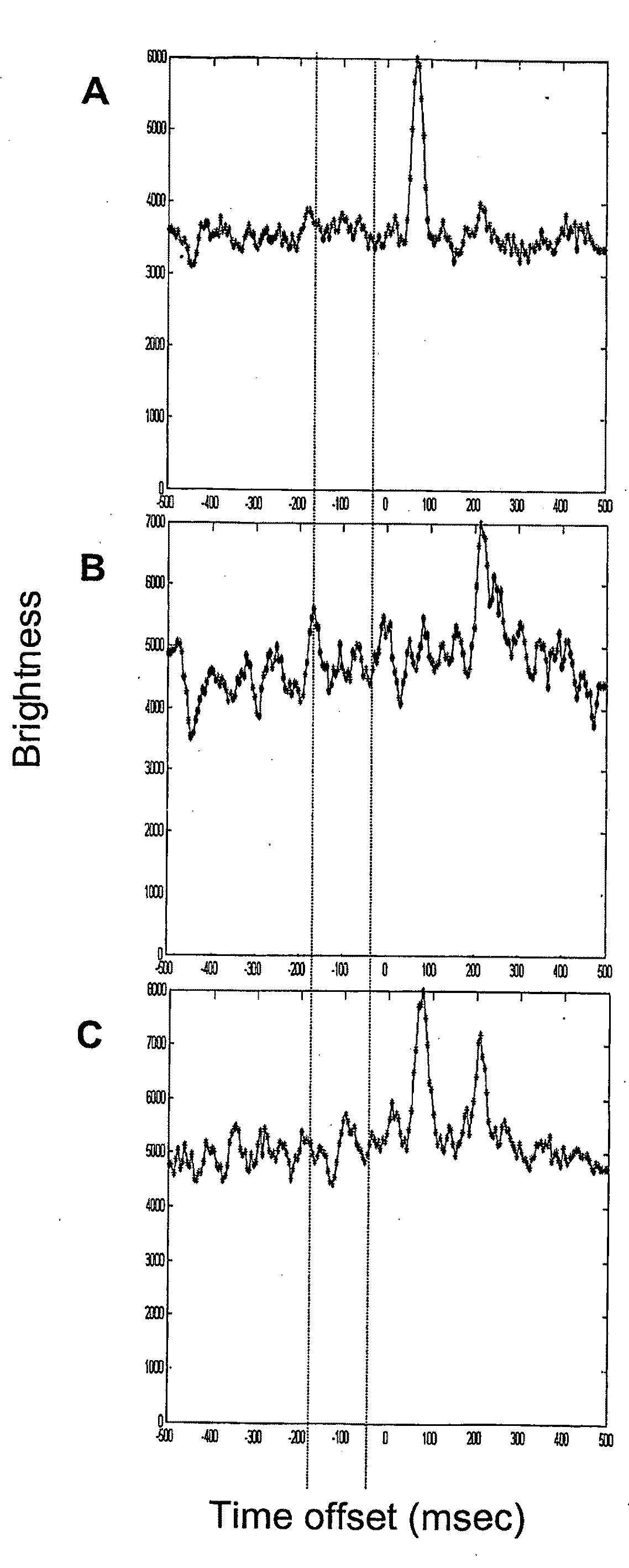Co-detection of single polypeptide and polynucleotide molecules
a technology applied in the field of co-detection of single polypeptides and polynucleotides, can solve the problems of limited vitro methods for co-detection of polypeptides and polynucleotides, significant time-consuming and laborious,
- Summary
- Abstract
- Description
- Claims
- Application Information
AI Technical Summary
Benefits of technology
Problems solved by technology
Method used
Image
Examples
example 1
Discrimination of a Protein and Nucleic Acid Directed Labeled with the Same Fluorescent Dye—Electrophoresis with Linear Polyacrlyamide
[0138]Samples of Alexa Fluor® 647-labeled IgG and 1.1 kb PCR product were prepared in 18 mM tris, 18 mM glycine, pH 8.6 with 0.2% linear polyacrylamide (LPA, 5,000,000-6,000,000 mw), 0.01% sodium dodecyl sulfate and 1 μg / ml each bovine serum albumin, Ficoll®, and polyvinylpyrrolidone. Samples were pumped into the SMD capillary, the pump was stopped, and an electric field was applied (300 V / cm). Cross-correlation of the molecules was determined as a function of time offset. One minute data sets were collected and analyzed.
[0139]Examples of the histogram plots of the molecule cross correlations are shown in FIG. 1. A. 26 fM Alexa Fluor 647 labeled IgG (cross-correlation peak at 75 msec). B. 10 fM Alexa Fluor labeled PCR product (peak at 220 msec). C. 13 fM Alexa Fluor 647 labeled IgG and 5 fM Alexa Fluor labeled PCR product (peaks at 75 and 215 msec).
example 2
Discrimination of a Protein and Nucleic Acid Directed Labeled with the Same Fluorescent Dye—Electrophoresis
[0140]SMD electrophoretic separation of a protein and a nucleic acid. Samples of Alexa Fluor® 647 labeled IgG and 1.1 kb PCR product were prepared in 18 mM tris, 18 mM glycine, pH 8.6 with 0.01% sodium dodecyl sulfate and 1 μg / ml each bovine serum albumin, Ficoll®, and polyvinylpyrrolidone. Samples were pumped into the SMD capillary, the pump was stopped, and an electric field was applied (150 V / cm). Cross-correlation of the molecules between channels 1 and 2 was determined as a function of time offset. One minute data sets were collected and analyzed. a: 52 fM Alexa Fluor 647 labeled IgG (cross-correlation peak at 210 msec). b: 20 fM Alexa Fluor labeled PCR product (peak at 175 msec). c: 26 fM Alexa Fluor 647 labeled IgG and 10 fM Alexa Fluor labeled PCR product (peaks at 170 and 215 msec).
example 3
Differences in the Characteristic Intensity of Fluorescence Emission were Used to Distinguish a Protein Complex and a Nucleic Acid within a Mixture
[0141]This example also demonstrates that the concentration of sample components can be determined by comparing the counts detected to a standard curve. The protein, PBXL-3, emits at a generally high intensity, and the nucleic acid, linearized pUC19, emits at a generally lower intensity. PBXL-3 is an intrinsically fluorescent protein complex. The pUC19 DNA was labeled with Alexa Fluor® 647 following the protocol of a ULYSIS® nucleic acid labeling kit (Molecular Probes, Inc. Eugene, Oreg.). PBLX-3-strepavidin was purchased from Martek Biosciences Corp. (Columbia, Md.). Phosphate Buffered Solution (PBS) (10 mM NaPO4, 150 mM NaCl, pH 7.2) was supplemented with 0.01% Casein Acid Hydrolysate and used to make dilution series (2.5, 5, 7.5, 10 and 20 fM) of protein alone, nucleic acid alone or mixtures of both. Samples were moved through the anal...
PUM
| Property | Measurement | Unit |
|---|---|---|
| Pressure | aaaaa | aaaaa |
| Volume | aaaaa | aaaaa |
| Intrinsic viscosity | aaaaa | aaaaa |
Abstract
Description
Claims
Application Information
 Login to View More
Login to View More - R&D
- Intellectual Property
- Life Sciences
- Materials
- Tech Scout
- Unparalleled Data Quality
- Higher Quality Content
- 60% Fewer Hallucinations
Browse by: Latest US Patents, China's latest patents, Technical Efficacy Thesaurus, Application Domain, Technology Topic, Popular Technical Reports.
© 2025 PatSnap. All rights reserved.Legal|Privacy policy|Modern Slavery Act Transparency Statement|Sitemap|About US| Contact US: help@patsnap.com



